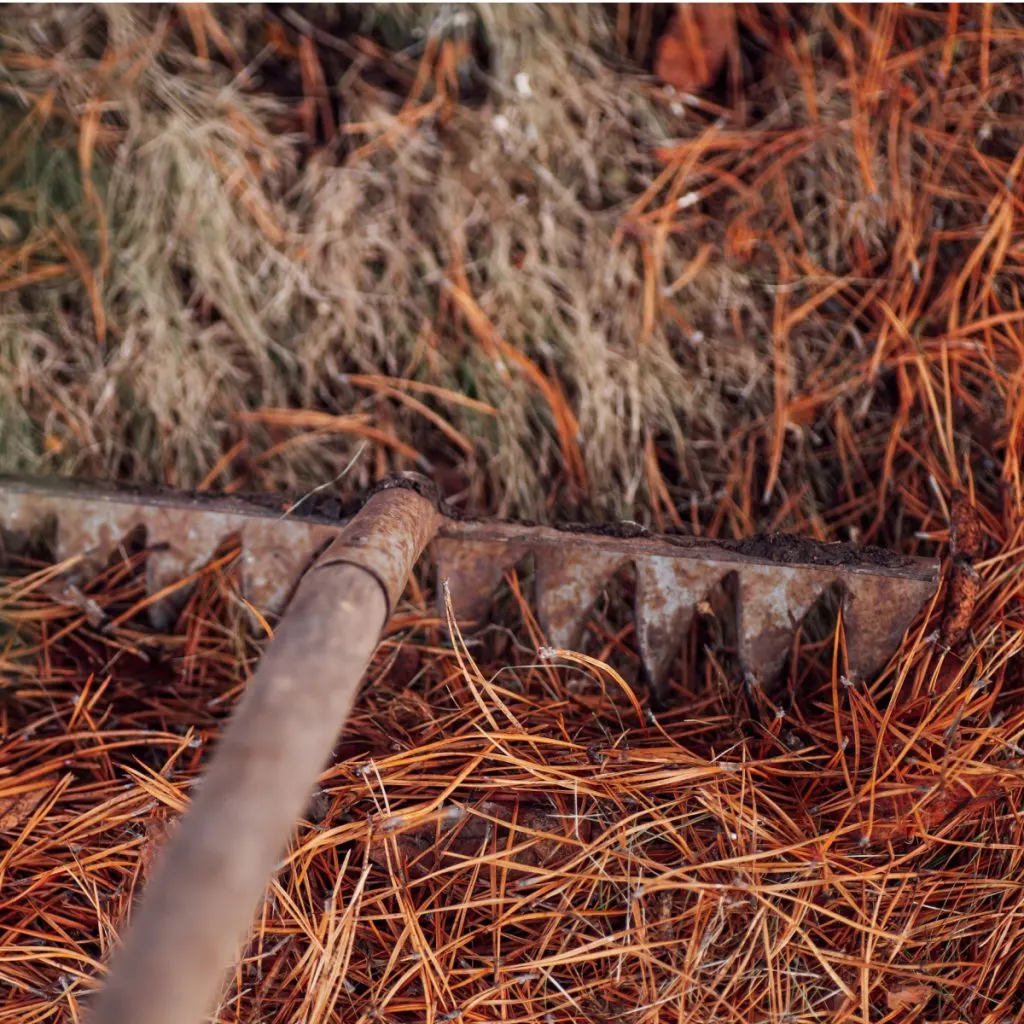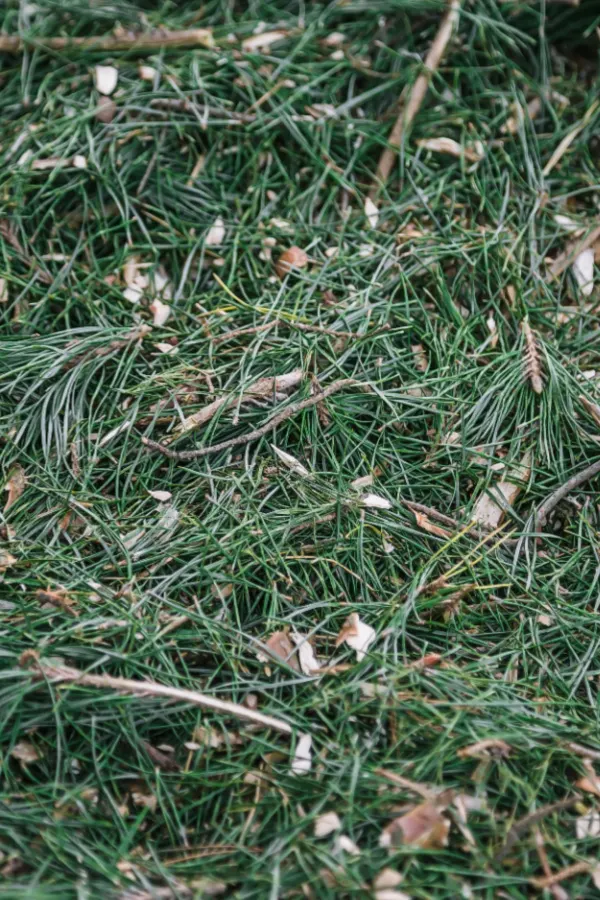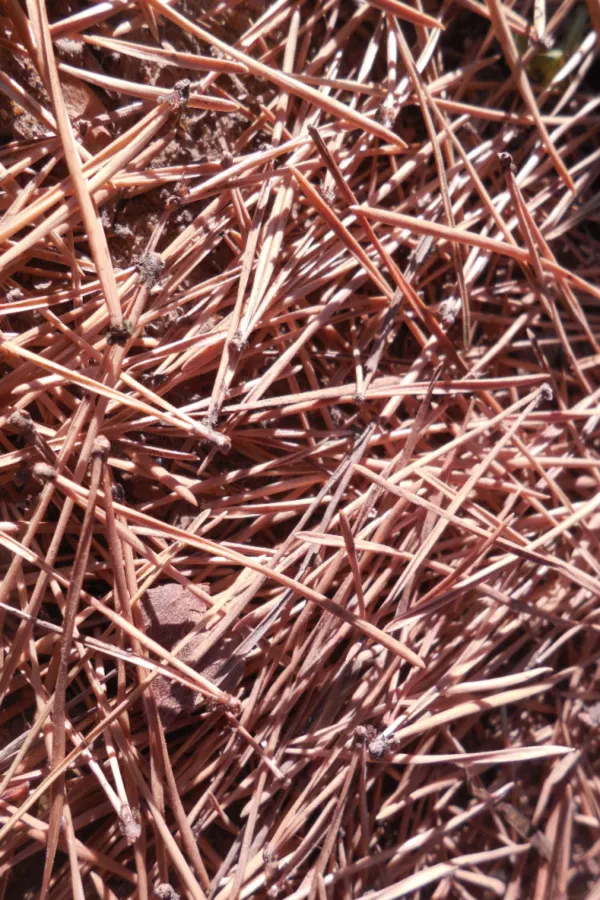Wondering how to best use all of those pine needles that have fallen down to the ground from your pine trees – and whether or not they are safe to use in your flowerbeds, gardens, compost pile and more?
Pine needles are one of the most misunderstood organic materials around. Especially when it comes to when, where and how to use them in the landscape. Gardeners are just not always sure how to use them, or if they can even be used at all.
Are they good for a compost pile? Can you use them as a mulch for annuals and perennials in flowerbeds? What about in the garden around vegetable plants? And finally, one of the biggest questions of all – are pine needles acidic – and if so, can’t they change the soil’s pH and harm plants?

The truth is that pine needles can be an amazing free resource for gardeners. But with that said, it’s important to know where you can use them, and where you shouldn’t. And that all starts by knowing the answer to that “big question” – are pine needles acidic or not. As it turns out, the answer is yes – and no!
Are Pine Needles Acidic? The Best Way To Use Pine Needles In Flowerbeds, Gardens & More
Many worry that using old pine needles that have fallen to the ground as a mulch will add acidity to their soil. The surprising news is that it doesn’t in the least. Not when they first fall down, or even as they slowly break down over time.
Once needles from a pine tree have died off and fallen to the ground, they are simply not acidic. And using them to mulch flowers or vegetable plants will not harm plants. Nor will it ever change the soil’s pH. Which means, as you will see below, in many situations, they can make for a great mulch.
So where does all of the confusion come from about pine needles and acidity? It stems from the fact that when fresh and green, pine needles are acidic. And even more, when those green needles are placed on the soil surface, it can help to lower a soil’s pH over time by leaching that acidity into the ground.

For plants that prefer alkaline soil, that can spell trouble. But for many acid loving plants, green needles can be a big help. So now that we have covered when pine needles are acidic and when they aren’t – we will not take a look at how and where each type can be used in your landscape successfully – and where they can’t!
The Best Way To Use Pine Needles In Flowerbeds, Gardens & More
Old Pine Needles In Flowerbeds
Let’s cover old pine needles first. To clarify, these are needles that are no longer green, and are often in various shades of red or brown.
One of the best uses for old pine needles is in flowerbeds as a mulch. And can it ever be a great way to save on the cost of traditional hardwood or bark mulch. The good thing about pine is that not only is it readily available, it also takes a long time to break down, lasting far longer than regular mulches. But when using pine as a mulch, there are a few things to keep in mind.
First and foremost, to use in flowerbeds, you will need to increase the overall thickness when mulching. With traditional mulch, a four to five inch layer is sufficient for weed control. But with pine needles, because of their light and wispy structure, a six to eight inch depth is needed to be effective.
At this thickness, the needles can successfully keep weeds out and help insulate the soil from temperature swings. It can also aid in keeping valuable moisture in the soil for your plants as well.

The good news here is that pine needles are free for the taking. Unlike with traditional hardwood mulch, adding a few more inches isn’t costly. Even more, needles break down at a very slow rate, so you won’t need to add nearly as much to your flowerbeds to replenish a thick layer each season.
Old Pine Needles In A Vegetable Garden
Believe it or not, pine needles have a couple of great uses in vegetable gardens as well. For starters, they make for an excellent ground cover under sprawling plants like cucumbers, zucchini, pumpkins, melons and more.
All of these crops produce their fruit on vines. And allowing that fruit to touch bare soil can quickly lead to rot, insect damage and more. But by simply spreading out a layer of needles on the bare soil, you can protect your plants and your harvest with ease. All while not having to use expensive straw or other mulches!
Old pine needles are also excellent for creating long lasting paths and walkways in gardens, flowerbeds and all throughout your landscape. Their loose nature allows water to pass through easily, and the needles help keep feet free of dirt and mud wherever you place them.
Listen In To Our Latest Podcast!

Where Not To Use Old Needles
There are a few plants in the garden it’s best to avoid using pine needles around. This includes more upright growing plants like tomatoes, peppers, corn and beans. Why? Because these plants need to be better protected and powered by traditional mulches such as compost, straw or even grass clippings.
It’s not that the needles will harm the plants, but more that they can’t provide adequate insulation, weed control and moisture retention.
Last but not least, whether old or green, needles are always best left out of home compost piles. Yes, they will eventually break down. And yes, they are not acidic – but they decompose at such a slow rate they can cause a compost pile to take years to be ready instead of mere months.
Where To Use Green (Fresh) Pine Needles
Just like old needles, green or fresh needles have their place in the home landscape. They are excellent as a mulch for acid loving plants such as blueberries and strawberries, as well as azaleas, camellias, hydrangeas, rhododendrons and magnolias. See: How To Fertilize Blueberries!
By simply placing a few inches of green needles as a mulch under plants, the needles will slowly leach in to help lower the pH and energize the soil. And if you happen to be planting any of the above plants – place a one to two inch layer in the bottom of the planting hole as you plant. It can provide that same boost of acid loving power to get them off to a great start!
Here is to finding a way to use all of those needles in your landscape this year!
Simple Garden Life
Follow Our Facebook Page For Even More Great Tips! Simple Garden Life Facebook Page
Simple Garden Life is a website dedicated to keeping gardening fun, simple and enjoyable! We publish two new articles each week along with a new garden podcast episode every two weeks. This article may contain affiliate links.
